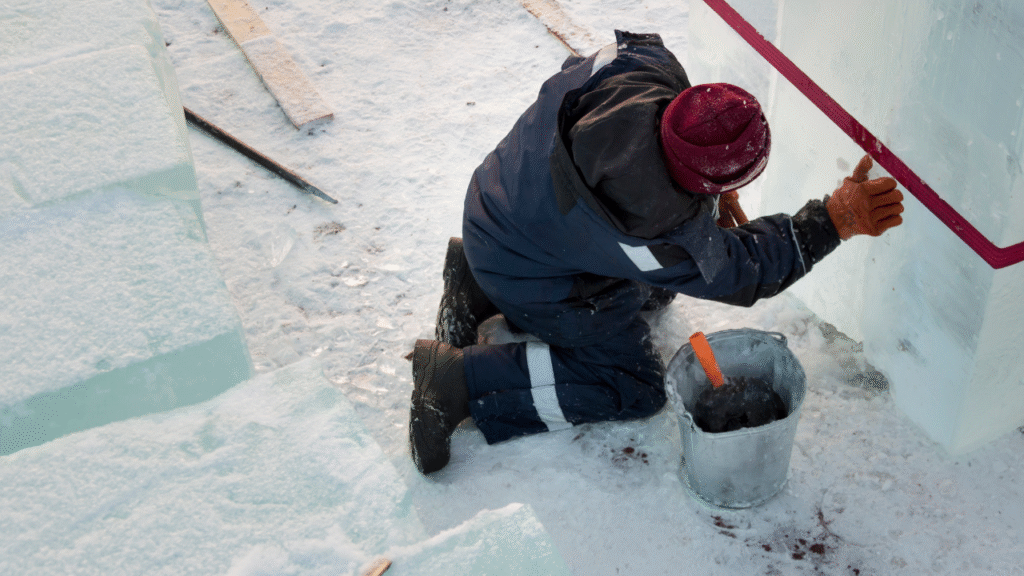Bracing for the Chill!
Winter in Ontario is beautiful, but for construction sites, it brings a unique set of challenges. Freezing temperatures, snow, and ice don’t just make the job harder; they significantly increase the risk of accidents and injuries. As companies across the province gear up for the colder months, a proactive and robust winter safety plan isn’t just good practice – it’s crucial for protecting your workforce and maintaining productivity.
Here at Auspice Safety, we’re committed to fostering safe working environments year-round. Let’s delve into the key areas Ontario construction companies need to focus on to ensure winter safety.
What Makes Our Winters Unique?
Ontario’s winters are characterized by:
- Extreme Cold: Temperatures can plummet well below freezing, leading to risks of frostbite and hypothermia.
- Heavy Snowfall: Significant accumulation can obscure hazards, create slippery surfaces, and add structural load to temporary structures.
- Ice Accumulation: Freezing rain and thaw-freeze cycles create incredibly dangerous icy conditions on walking surfaces, equipment, and even materials.
- Shorter Daylight Hours: Reduced visibility increases the likelihood of incidents, especially during critical operations.
Key Pillars of Winter Safety on Site
1. Personal Protective Equipment (PPE) – Beyond the Basics
While hard hats, safety boots, and high-vis vests are standard, winter demands specialized PPE:
- Layered Clothing: Encourage workers to dress in layers, allowing them to adjust to changing temperatures and activity levels. Moisture-wicking base layers are essential.
- Insulated, Waterproof Outerwear: Jackets, pants, and gloves must be insulated and waterproof to protect against cold, wind, and snow.
- Head Protection: Insulated liners for hard hats are crucial. Balaclavas or neck gaiters can protect exposed skin.
- Footwear: Insulated, waterproof safety boots with excellent slip-resistant soles are a must. Consider ice cleats for added traction on icy surfaces.
- Hand Protection: Multiple pairs of insulated gloves (with touch-screen compatibility if needed for devices) should be available.
2. Site Management & Housekeeping – Clearing the Way for Safety
A tidy site is always a safer site, but this is amplified in winter.
- Snow and Ice Removal: Implement a strict schedule for clearing snow and ice from walkways, access points, emergency exits, and around equipment. Use sand or non-slip grit generously.
- De-icing Strategies: Have a plan for de-icing critical areas, including ramps, stairs, and scaffolding platforms.
- Material Storage: Store materials off the ground and under cover where possible to prevent them from freezing to the ground or becoming encrusted with ice.
- Emergency Access: Ensure emergency routes and muster points are always clear and accessible.
3. Equipment and Machinery – Winterizing Your Fleet
Cold weather significantly impacts machinery performance and safety.
- Pre-Shift Inspections: More rigorous pre-shift checks are needed, focusing on fluid levels, tire pressure, brakes, lights, and defrosting systems.
- Winterized Fluids: Use appropriate winter-grade oils, coolants, and fuels.
- Battery Maintenance: Cold weather drains batteries faster. Ensure batteries are in good condition and regularly checked.
- Clear Visibility: Ensure all windows, mirrors, and lights on vehicles and heavy equipment are clear of snow and ice before operation.
- Safe Operation: Remind operators to reduce speeds and be extra cautious on slippery surfaces.
4. Worker Welfare & Health – Protecting Against the Elements
The human body is vulnerable to extreme cold.
- Warm-up Breaks: Provide heated shelters or designated warm-up areas for workers to take frequent breaks. Ensure access to hot beverages.
- Monitoring for Cold Stress: Train supervisors and workers to recognize the signs of frostbite, hypothermia, and trench foot. Implement a buddy system.
- Hydration: Despite the cold, workers still need to stay hydrated. Avoid excessive caffeine.
- Sun Protection: Even in winter, UV rays can be strong, especially with snow reflection. Encourage sunscreen use for exposed skin.
5. Fall Protection – A Heightened Risk
Falls are a leading cause of injury on construction sites, and winter conditions exacerbate this risk.
- Ice on Working Surfaces: Thoroughly clear and de-ice all elevated working platforms, scaffolding, and roofs before work begins.
- Harness & Lanyard Inspection: Ensure fall protection equipment is free of ice and fully functional. Ice can compromise components.
- Guardrails: Regularly inspect guardrails and ensure they are free of ice build-up that could reduce their effectiveness or create a slipping hazard.
6. Training and Communication – Empowering Your Team
Effective communication and training are paramount.
- Winter Safety Toolbox Talks: Conduct regular toolbox talks specifically addressing winter hazards and safe work procedures.
- Emergency Procedures: Review emergency response plans, including what to do in case of cold-related illness or accidents in winter conditions.
- Encourage Reporting: Foster a culture where workers feel comfortable reporting hazards and near misses promptly.
The Bottom Line
Winter on an Ontario construction site demands heightened vigilance and a comprehensive approach to safety. By focusing on appropriate PPE, rigorous site management, equipment maintenance, worker welfare, robust fall protection, and continuous training, companies can significantly mitigate risks.
Start preparing now to ensure your team stays safe, healthy, and productive throughout the colder months.
Stay safe out there, Ontario!

